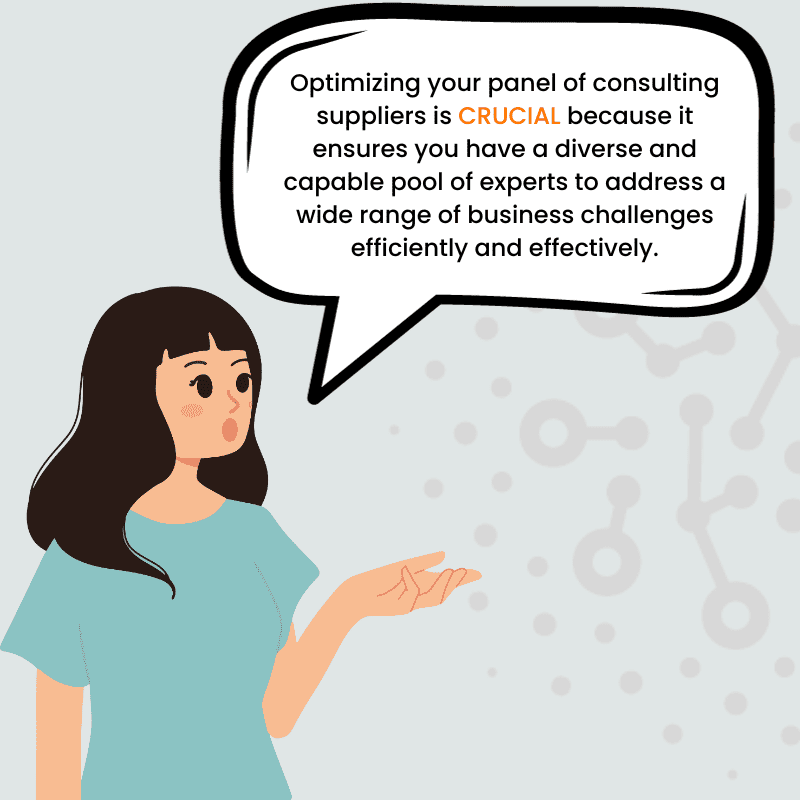In the intricate dance of business, curating the right panel of consulting suppliers is paramount. As Matthew Stewart aptly puts it, “The core of the consulting business is going in and essentially making yourself indispensable by eating the brain of the organization, meaning consultants go in and assume key functions in the organization.”
Their influence extends beyond mere advisory roles; they become pivotal cogs driving change and expertise. But with such profound influence comes the responsibility for businesses to choose wisely. How does one ensure this panel seamlessly aligns with internal goals and challenges?
Join us as we explore the art of optimizing your panel of consulting suppliers to meet the demands of today and anticipate those of tomorrow.
Why is Optimization Essential?
Engaging with a consultant is a significant investment, both in terms of money and trust. Understanding the reasons for optimization can help ensure that every engagement adds value to your organization.
Maximize ROI: Every consulting project comes at a cost. Ensuring you work with the best guarantees a higher return on your investment. An optimized panel means you’re always getting the best value for money.
Stay Ahead of Industry Shifts: The business environment is perpetually changing. To stay competitive, companies must be agile, and so should their consulting partners. An optimized panel ensures that you’re always in tandem with the latest in industry trends and insights.
Risk Management: Over-reliance on a single consulting supplier or engaging with underperformers can be a strategic risk. By regularly refining your panel of consulting suppliers, you mitigate such potential pitfalls.
Ensuring Fresh Perspectives: Just as businesses evolve, so do challenges. An optimized panel ensures a diversity of perspectives, leading to more innovative solutions.
Where to Start: Laying the Groundwork
Embarking on an optimization journey requires clarity and the unified vision of leadership. Before delving deep into the specifics, it’s essential to gauge where your organization stands, the path it aims to take, and ensuring you have the robust backing of the top leadership and management buy-in.
Internal Assessment: Before looking outwards, look inwards. Understand your business needs, both current and future. What gaps or challenges do you foresee? This will guide the kind of expertise you’ll be sourcing.
Forecasting future needs is vital, but so is a thorough analysis of your current roster. It helps in identifying what you already have at your disposal and what’s missing.
Leadership and Management Buy-In: Central to any significant organizational change is the commitment from those at the top. This isn’t just about allocating resources but about embracing a vision where consultants play a strategic role in the company’s journey.
It’s essential to have the leaders not only back the initiative but actively participate in the process. This not only provides the necessary impetus for the initiative but ensures that the changes made are sustainable and in line with the company’s overarching goals.

Deep Dive: Performance Diagnosis
The essence of optimization lies in performance evaluation. It’s not just about who’s delivering, but how and why. A thorough performance diagnosis is the key to identifying the most valuable partners.
Quantitative Analysis: This involves looking at tangible metrics – project delivery times, cost-effectiveness, ROI generated, and more. It gives a clear picture of which consultants are consistently meeting or exceeding expectations.
Qualitative Analysis: This delves into the softer aspects – team dynamics, communication effectiveness, adaptability, and more. Sometimes, even if the numbers look good, a consultant might not be the right fit culturally or in terms of work dynamics.
Holistic Assessment: Combine both quantitative and qualitative analyses. This ensures that the consulting firms you engage with are not only delivering results but are also a good fit for your organization’s ethos and working style.
The Optimization Process
Armed with insights and data, the actual optimization begins. This process is a blend of decision-making, strategy, and foresight, ensuring your panel is always in its prime and dynamically evolving with your business’s requirements.
1. Addressing and Adapting to Business Needs
Addressing Core Needs: Ensure that your panel adequately covers the pivotal needs of your organization. While 100% coverage may be ambitious, strive for at least 80%. Remember, the quality of coverage is as important as its quantity. An effective panel will provide depth in crucial areas rather than merely touching upon every need superficially.
Adapting to Evolving Needs: Business needs are not static; they evolve with market dynamics, technological advancements, and organizational strategy shifts.
Regularly review your requirements, compare them with your panel’s capabilities, and recalibrate as needed. This ensures that you’re not just responding to today’s challenges but also preparing for tomorrows.
2. Streamlining Performance
Phase Out Low-performers: Your diagnostic evaluation will spotlight underperformers. To maintain consistent value delivery, it’s essential to let go of these weak links.
Spot and Engage Rising Stars: The consulting arena is vast, with new high-performers emerging continually. Stay updated with market trends and integrate consultants that align with your evolving needs.
3. Diversifying Your Panel
Bench Strength: Ensure you have a diverse set of high-performers for each strategic need. A varied panel not only prevents over-reliance on a few but also seeds innovation through diverse perspectives.
Global Sourcing: Go beyond local talents. Tapping into global expertise can provide a broader range of insights. Different regions have their unique strengths, and a diversified panel can offer a more holistic approach.
The path to optimization is not a one-time task but an ongoing journey. With the business landscape in constant flux, regularly reviewing and refining your panel ensures it remains relevant, robust, and ready to address any challenge.
In Conclusion: Optimizing Your Panel of Consulting Suppliers
In today’s rapidly changing business landscape, a well-optimized panel of consulting suppliers is indispensable.
Think of it not just as a list, but as a dynamic ecosystem where each consultant brings unique value. It’s not solely about numbers; it’s about strategic alignment and adaptability to evolving business needs.
Endorsement from top leadership and management’s buy-in are pivotal. With their backing, the panel becomes more than just a roster—it’s a strategic tool, fostering innovation and agility.
To summarize, by refining and realigning your consultant panel, you don’t merely adjust a resource; you proactively shape your organization’s trajectory, ensuring readiness for both current challenges and future opportunities.
panel of consulting suppliers panel of consulting suppliers panel of consulting suppliers
panel of consulting suppliers panel of consulting suppliers panel of consulting suppliers
panel of consulting suppliers panel of consulting suppliers panel of consulting suppliers

How Consource Can Help?
An optimized supplier panel is a strategic asset for your organization, and Consource can be your ally in creating, maintaining, and nurturing it. With its centralized supplier database, real-time performance tracking and assessment system, and integrated consulting database, Consource transforms your supplier panel into a team of trusted collaborators.








0 Comments